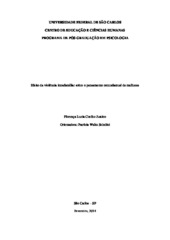| dc.contributor.author | Justino, Florença Lucia Coelho | |
| dc.date.accessioned | 2016-06-02T20:30:58Z | |
| dc.date.available | 2014-09-11 | |
| dc.date.available | 2016-06-02T20:30:58Z | |
| dc.date.issued | 2014-02-28 | |
| dc.identifier.citation | JUSTINO, Florença Lucia Coelho. Effects of violence in counterfactual thinking of women. 2014. 235 f. Dissertação (Mestrado em Ciências Humanas) - Universidade Federal de São Carlos, São Carlos, 2014. | por |
| dc.identifier.uri | https://repositorio.ufscar.br/handle/ufscar/6055 | |
| dc.description.abstract | Thinking about what have happened or thinking counterfactually is an important type of imagination thinking and may be defined as thoughts about alternatives to something that have been experienced in order to change the sequence of events or modify what happened with the purpose of reaching a different outcome. Considering that counterfactual thinking is insert in the imaginative function and recognizing the importance of imaginative thinking as a significant form of adaptation to reality, which can be achieve through the modification of elements, the aims of this work are: elaborate and evaluate a technique for evaluation of counterfactual thinking in adults (Study 1) and assess the extent to which victimization as a traumatic experience influences the generation of specific types of counterfactual thinking, ensuring if there will be differences in counterfactual thinking generated by women victims of violence and women which do not (Study 2). The material was composed by five stories adapted from newspapers and magazines articles followed by questions and four modification alternatives. Considering the high concordance among judges at the end of the fourth evaluation, the material produced is adequate to assess counterfactual thinking in adults. The material developed was presented to 16 women victims of violent and to 20 not victimized. Content analysis and frequency of categories were conducted to analyze the free and direct report modification responses. Regarding the modification alternatives, the frequency of responses and the means were calculated for both groups. The Student s t-test was conducted to verify the statistics meaning of the mean s differences. Most of the thoughts were classified as upward, subtractive, self referent and referring to the action aspect. Altogether, the pattern of thoughts were similar in both groups. The first story was discriminative once it was the one from which the differences between groups were revealed. | eng |
| dc.description.sponsorship | Universidade Federal de Minas Gerais | |
| dc.format | application/pdf | por |
| dc.language | por | por |
| dc.publisher | Universidade Federal de São Carlos | por |
| dc.rights | Acesso Aberto | por |
| dc.subject | Imaginação | por |
| dc.subject | Modificação da realidade | por |
| dc.subject | Violência | por |
| dc.subject | Imagination | eng |
| dc.subject | Modification of reality | eng |
| dc.subject | Violence against women | eng |
| dc.title | Efeito da violência intrafamiliar sobre o pensamento contrafactual de mulheres | por |
| dc.title.alternative | Effects of violence in counterfactual thinking of women | eng |
| dc.type | Dissertação | por |
| dc.contributor.advisor1 | Schelini, Patrícia Waltz | |
| dc.contributor.advisor1Lattes | http://lattes.cnpq.br/6185333517392859 | por |
| dc.description.resumo | Os pensamentos sobre o que não aconteceu, ou pensamentos contrafactuais, são um tipo importante de pensamento imaginativo, podendo ser definidos como pensamentos sobre alternativas a um fato já experienciado, visando alterar a sequência de acontecimentos ou modificar o ocorrido com o objetivo de chegar a um desfecho diferente do que realmente ocorreu. Considerando que o pensamento contrafactual está inserido na função imaginativa e reconhecendo a importância do processo imaginativo como uma forma significativa de adaptação à realidade, adaptação esta que pode se dar por meio da modificação de elementos, o presente trabalho terá como objetivos: elaborar e avaliar uma proposta de técnica para a avaliação do pensamento contrafactual em adultos (Estudo 1) e avaliar em que medida o fator vitimização, ou seja, a experiência da violência enquanto evento traumático influencia na elaboração de tipos específicos de contrafato, verificando se haverá diferenças no estilo do pensamento contrafactual de mulheres vítimas de violência e mulheres não vitimizadas (Estudo 2). O material elaborado foi constituído por cinco estórias adaptadas de jornais e revistas, seguidas de quatro alternativas de modificação. Foram necessárias quatro avaliações até que todas as alternativas atingissem o nível de concordância satisfatório. Considerando a elevada concordância entre os juízes ao final das quatro avaliações, julgou-se que o material elaborado encontra-se adequado para avaliar o pensamento contrafactual em adultos. O material elaborado foi apresentado a 16 mulheres vítimas de violência e a 20 mulheres não vitimizadas. Foi realizada análise de conteúdo dos pensamentos contrafctuais espontâneos e direcionados. Os pensamentos foram categorizados e a frequência contabilizada. Em relação às alternativas foi contabilizada a frequência de respostas por grupo e as médias foram calculadas. O teste t de Student foi conduzida com o intuito de verificar o significado estatístico das diferenças entres as médias. A maioria dos pensamentos encontrados foram categorizados como ascendentes, subtrativos, autorreferentes e modificaram o aspecto referente à ação/inação. De modo geral, o padrão de pensamentos elaborados pelos grupos foi similar. A Estória 1 foi discriminativa, uma vez que foi a estória a partir da qual diferenças entre os grupos foram reveladas. | por |
| dc.publisher.country | BR | por |
| dc.publisher.initials | UFSCar | por |
| dc.publisher.program | Programa de Pós-Graduação em Psicologia - PPGPsi | por |
| dc.subject.cnpq | CIENCIAS HUMANAS::PSICOLOGIA | por |
| dc.contributor.authorlattes | http://lattes.cnpq.br/9103038882479439 | por |
